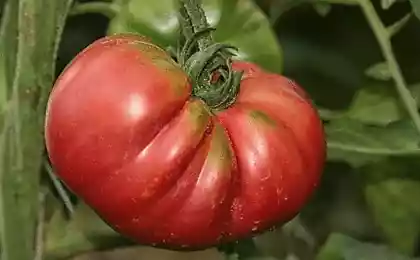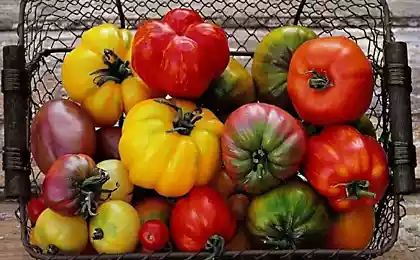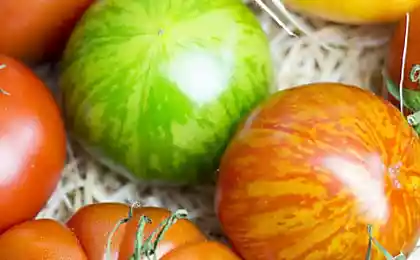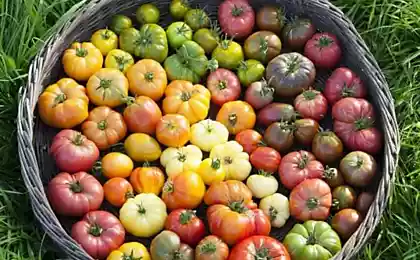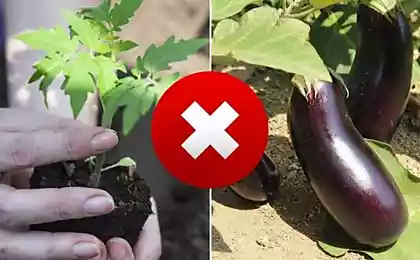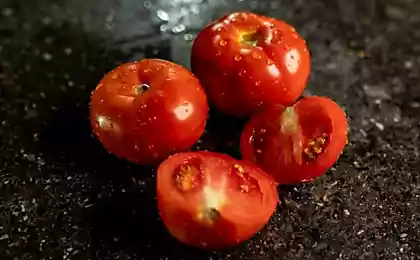183
Folk methods of combating phytofluorosis tomato
Until mid-summer, the phytofluoro lurks, and our tomatoes grow and improve to the delight of the eyes and heart. But you can not relax in any case - rarely which area this insidious fungus will bypass "by itself". (You can read about this disease and how infection occurs in the article “What is phytofluoro”).
The army of mushroom spores destroys a huge part of the harvest every year. But with the persistent onset of infection, the number of prescriptions against it increases. Our summer residents do not sit idly by, and every year the treasury of useful tips is replenished with new and new methods of fighting the disease! I hope that these fairly simple, cheap, but well-working methods of prevention and treatment will help you beat the phytoftora on your site.
1. The spores of the mushroom die from garlic. The first spraying should be carried out before the formation of the ovary, the second - 10 days after the first. Then, if you spray tomato bushes with garlic infusion every 12-15 days, the result will be.
2. This treatment creates a protective film on the leaves, which will restrain the infection through the stomata. But! remember that this is a preventive measure, not a treatment, so first carefully examine the bush and remove the already damaged leaves!
3. Kefir spraying is also a preventive tool. The first such spraying is recommended not later than 10-14 days after planting seedlings in the ground. Then it is advisable to do it weekly.
4. Dairy-iodine spraying is a well-proven method. Moreover, the antimicrobial properties of iodine have been known since childhood. He'll bring order to the tomato leaves, and he'll speed up the ripening of our tomatoes.
5. They are carried out 3 times a season: as soon as the seedlings take root, before the flowering of tomatoes and immediately after the first ovaries appear.
6. Such spraying can restrain the infection of tomatoes with phytofluorosis for quite a long time. It is recommended to spray once every 10 days in the morning in quiet and preferably windless weather. Good to process at the time of tying fruits. At the first manifestations of phytophthorosis, immediately carry out additional processing.
7. A well-proven method patented by German scientists: winding the roots of seedlings before landing in the ground with copper wire. Our summer residents use copper wire in a different way: pierce the stem of the tomato. Copper microdoses stabilize chlorophyll, stimulate plant respiration and enhance oxidative processes. This strengthens the plant and makes it more resistant to infection.Attention! This procedure is done only when the stem of the tomato becomes strong!
So we got acquainted with various methods of combating tomato phytofluoro. It will be very cool, pleasant and useful if you replenish this piggy bank with your findings and secrets. In the meantime, good luck to all in the fight against insidious infection - phytofluora!
Source: www.7dach.ru
The army of mushroom spores destroys a huge part of the harvest every year. But with the persistent onset of infection, the number of prescriptions against it increases. Our summer residents do not sit idly by, and every year the treasury of useful tips is replenished with new and new methods of fighting the disease! I hope that these fairly simple, cheap, but well-working methods of prevention and treatment will help you beat the phytoftora on your site.
1. The spores of the mushroom die from garlic. The first spraying should be carried out before the formation of the ovary, the second - 10 days after the first. Then, if you spray tomato bushes with garlic infusion every 12-15 days, the result will be.
- Recipe: For 10 liters of water - 1-1.5 cups of crushed heads and shoots of garlic (mesga) + 1.5-2 g of permanganate. Garlic in the water to insist the day. Strain and add permanganate.
2. This treatment creates a protective film on the leaves, which will restrain the infection through the stomata. But! remember that this is a preventive measure, not a treatment, so first carefully examine the bush and remove the already damaged leaves!
- Recipe: For 10 liters of water - 1 glass of table salt.
3. Kefir spraying is also a preventive tool. The first such spraying is recommended not later than 10-14 days after planting seedlings in the ground. Then it is advisable to do it weekly.
- Recipe: 10 liters of water - 1 liter of kefir, which for two days should "ferment". Stir thoroughly.
4. Dairy-iodine spraying is a well-proven method. Moreover, the antimicrobial properties of iodine have been known since childhood. He'll bring order to the tomato leaves, and he'll speed up the ripening of our tomatoes.
- Recipe: For 10 liters of water - 1 liter of low-fat milk + 20 drops of iodine
5. They are carried out 3 times a season: as soon as the seedlings take root, before the flowering of tomatoes and immediately after the first ovaries appear.
- Recipe:For 10 liters of water, half a bucket of ash. Stir, insist for 3 days, periodically stirring. Let's stand still. Settled drug bring to a volume of 30 liters, add 30-35 grams of soap - household or liquid.
6. Such spraying can restrain the infection of tomatoes with phytofluorosis for quite a long time. It is recommended to spray once every 10 days in the morning in quiet and preferably windless weather. Good to process at the time of tying fruits. At the first manifestations of phytophthorosis, immediately carry out additional processing.
- Recipe: 1 liter of water 100 g of mushroom. Dried mushroom to pass through a meat grinder or grind with a knife. Pour boiling water (brew), after cooling, strain.
7. A well-proven method patented by German scientists: winding the roots of seedlings before landing in the ground with copper wire. Our summer residents use copper wire in a different way: pierce the stem of the tomato. Copper microdoses stabilize chlorophyll, stimulate plant respiration and enhance oxidative processes. This strengthens the plant and makes it more resistant to infection.Attention! This procedure is done only when the stem of the tomato becomes strong!
- Recipe: Thin copper wire calcined (can be cleaned with sandpaper), cut in pieces of 3-4 cm. At a distance of 10 cm from the soil, puncture the stem, insert a piece of wire, bend the ends down. Don't wrap around the stem!
So we got acquainted with various methods of combating tomato phytofluoro. It will be very cool, pleasant and useful if you replenish this piggy bank with your findings and secrets. In the meantime, good luck to all in the fight against insidious infection - phytofluora!
Source: www.7dach.ru

